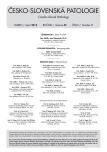Undiagnosed Whipple’s disease with a lethal outcome
Authors:
Daniel Farkaš 1; Marián Švajdler ml. 2; Silvia Farkašová Iannaccone 3; Peter Labaj 1
Authors place of work:
Úrad pre dohľad nad zdravotnou starostlivosťou, SLaPA pracovisko, Košice
1; Oddelenie patológie UN LP Košice, Košice
2; Ústav súdneho lekárstva UPJŠ LF, Košice
3
Published in the journal:
Čes.-slov. Patol., 49, 2013, No. 2, p. 95-98
Category:
Původní práce
Summary
Whipple’s disease is a rare multisystem disease caused by rod-shaped bacteria Tropheryma whipplei. Although it affects all age groups, the typical patient is a middle-aged white man. The clinical signs are very heterogeneous and depend on the stage of the disease. The most common is abdominal manifestation characterized by weight loss, disability, chronic diarrhea and abdominal pain. Untreated Whipple’s disease is almost always fatal. We describe probably the first published case of undiagnosed Whipple’s disease with a lethal outcome in Slovakia, occuring in a 33-year old white man with involvement of the gastrointestinal tract, abdominal lymphatic nodes and brain, who died of bronchopneumonia.
Keywords:
Whipple’s disease – Tropheryma whipplei – neuropathology
Zdroje
1. Lauwers G, Mino-Kenudson M,. Kradin RL. Infections of the Gastrointestinal Tract. In: Kradin RL, ed. Diagnostic pathology of infectious disease. Philadelphia, Saunders/Elsevier; 2010: 215-254.
2. Rusina R, Keller O, Šíma R, Zámečník J. Peripheral neuropathy in Whipples disease: a case report. Cesk Patol 2012; 48(2): 97-99.
3. Arnold CA, Moreira RK, Lam-Himlin D, De Petris G, Montgomery E. Whipple disease a century after the initial description: increased recognition of unusual presentations, autoimmune comorbidities, and therapy effects. Am J Surg Pathol 2012; 36(7): 1066-1073.
4. Whipple GH. A hitherto undescribed disease characterized anatomically by deposits of fat and fatty acids in the intestinal and mesenteric lymphatic tissues. Bulletin of the Johns Hopkins Hospital 1907; 18: 382–391.
5. Black-Schaffer B. Tinctorial demonstration of a glycoprotein in Whippleęs disease. Proc Soc Exp Biol Med 1949; 72: 225-227.
6. Cohen AS, Schimmel EM, Holt PR, Isselbacher KJ. Ultrastructural abnormalities in Whippleęs disease. Proc Soc Exp Biol Med 1960; 105: 411-414.
7. Chears WC Jr, Ashworth CT. Electron microscopic study of the intestinal mucosa in Whipple’s disease. Demonstration of encapsulated bacilliform bodies in the lesion. Gastroenterology 1961; 41: 129-138.
8. Yardley JH, Hendrix TR. Combined electron and light microscopy in Whipple’s disease-demonstration of “bacillary bodies” in the intestine. John Hopkins Hosp Bull 1961; 109: 80-98.
9. Kojecký Z, Malinský J, Koďousek R, Maršálek E. Frequence of occurence of microbes in the intestinal mucosa and in the lymph nodes during a long term observation of a patient suffering from Whippleęs disease. Gastroenterologia 1964; 101: 163-172.
10. Relman DA, Schmidt TM, MacDermott RP, Falkow S. Identification of the uncultured bacillus of Whipple’s disease. N Engl J Med 1992; 327(5): 293–301.
11. Dumler JS, Baisden BL, Yardley JH, Raoult D. Immunodetection of Tropheryma whipplei in intestinal tissues from Dr. Whipple’s 1907 patient. N Engl J Med 2003; 348(14): 1411–1412.
12. Strayer DL, Rubin R, Rubin E. Rubin’s pathology: clinicopathologic foundations of medicine. Wolters Kluwer/Lippincott Williams & Wilkins: Philadelphia; 2008: 583.
13. Schneider T, Moos V, Loddenkemper C, Marth T, Fenollar F, Raoult D. Whipple’s disease: new aspects of pathogenesis and treatment. Lancet Infect Dis 2008; 8(3): 179–190.
14. Marth T. The diagnosis and treatment of Whipple’s disease. Curr Allergy Asthma Rep 2001; 1(6): 566–571.
15. Prayson AR. Neuropathology. Elsevier, Churchil Livingstone: Philadelphia; 2005: 296-297.
16. Graham DI, Lantos PL. Greenfieldęs Neuropathology, Volume 2 (6th edn). Oxford University Press, Arnold: London; 1997: 135-137.
17. Jackuliak P, Koller T, Baqi L, et al. Whipple’s disease-generalized stage. Digestive Diseases and Sciences 2008; 53(12): 3250-3258.
18. Marth T, Raoult D: Whipple’s disease. Lancet 2003; 361(9353): 239-246.
19. La Scola B, Fenollar F, Fournier PE, Altwegg M, Mallet MN, Raoult D. Description of Tropheryma whipplei gen. nov., sp. nov., the Whipple’s disease bacillus. Int J Syst Evol Microbiol 2001; 51(Pt 4): 1471–1479.
20. Schwartz MA, Selhorst JB, Ochs AL, et al. Oculomasticatory myorhythmia: a unique movement disorder occurring in Whipple’s disease. Ann Neurol 1986; 20(6): 677-683.
Štítky
Patologie Soudní lékařství ToxikologieČlánek vyšel v časopise
Česko-slovenská patologie

2013 Číslo 2
Nejčtenější v tomto čísle
- Nediagnostikovaná Whippleova choroba s letálnym koncom
- Primární velkobuněčný neuroendokrinní karcinom močového měchýře
- Životní jubileum prof. MUDr. Ctibora Povýšila, DrSc.
- Difuzní idiopatická hyperplázie neuroendokrinních buněk: popis případu a přehled literatury
